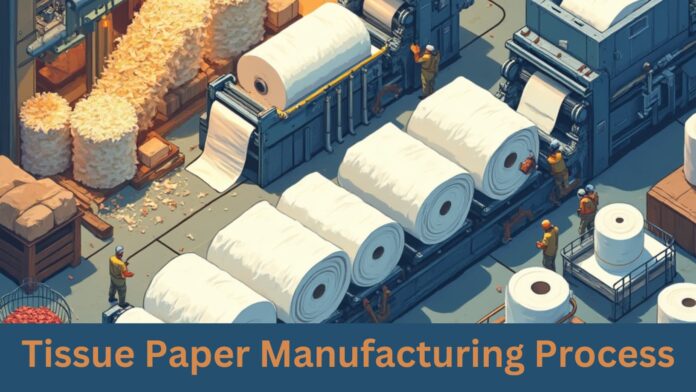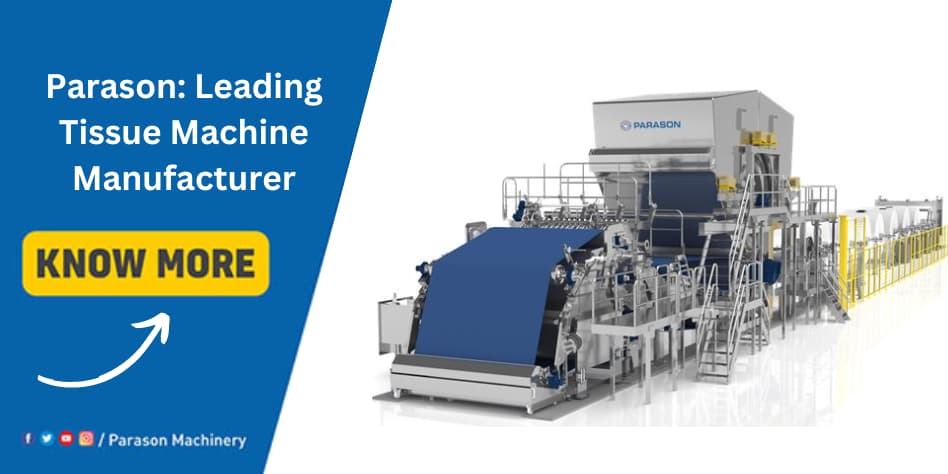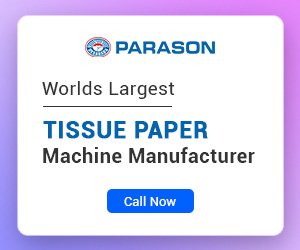Tissue paper is an essential product found in every household, office, and public space, serving various hygiene and cleaning purposes. Ever wondered how the tissue paper manufacturing process works?
Its production involves a complex yet fascinating process that ensures the creation of a product that is soft, absorbent, and suitable for multiple uses.
In this blog we will discuss the tissue paper manufacturing process, breaking it down step by step while covering the types of tissue paper available in the market, the raw materials used, and the machinery involved in the process.
Introduction
Tissue paper, a lightweight and highly absorbent paper, is primarily used for hygiene purposes. Its applications range from facial tissues and toilet paper to kitchen rolls and napkins. The tissue paper industry has witnessed significant growth due to the increasing demand for disposable and hygienic products. The annual growth of the tissue paper market is projected at a rate of 5.24 (CAGR)% from 2024 to 2028.
In 2024 the global market of tissue and hygiene paper is expected to get a revenue of $351.70 billion.
Types of Tissue Paper Used in the Market
As per the use of tissue paper in day-to-day life, there are various types and forms in which it can be divided. The following are the most common types used:
- Toilet Paper: Perhaps the most commonly used tissue product, toilet paper is designed for personal hygiene in the bathroom.
- Facial Tissues: These tissues are softer than toilet paper and are primarily used for facial hygiene, such as wiping the face or nose.
- Paper Towels: Paper towels are commonly used in kitchens for cleaning and drying purposes. These are heavier and more absorbent than facial tissues.
- Napkins: These are used in dining settings for wiping hands and cleaning up spills during meals.
- Wrapping Tissue: Lightweight and often used for wrapping gifts, wrapping tissue paper is designed for aesthetics rather than absorbency.
Each type of the above-mentioned tissue paper is manufactured using different processes and different raw materials or any special chemical to differ and get the required softness or hardness to the tissue paper. Let’s see the tissue paper manufacturing process now.
What is the Tissue Paper Manufacturing Process?
The tissue paper manufacturing process is quite different from than regular paper manufacturing process. There are some machines those are common but some special machines are used only to manufacture the tissue paper.
The tissue paper manufacturing process is a highly specialized one, involving several steps. These steps involve pulping, refining, screening, and other processes. Learn more about the detailed tissue paper manufacturing process and how to start a tissue paper manufacturing plant here.
The tissue paper manufacturing process is a highly specialized one, involving several steps. These steps involve pulping, refining, screening,
The tissue paper manufacturing process is a highly specialized one, involving several steps and the use of sophisticated machinery. The process typically starts with the pulping of raw materials, followed by refining, pressing, drying, and finally converting the large rolls of tissue paper into consumer-friendly products. The goal is to produce a paper that is soft, strong, and absorbent.
Raw Materials Used in Tissue Paper Manufacturing
The key to quality tissue paper lies in the raw materials used. The main raw materials for tissue paper production include:
- Virgin Pulp: The virgin pulp is made from fresh wood fiber. It is the purest raw material which gives the best quality of paper. It is soft, strong, and absorbent.
- Recycled Pulp: The recycled pulp used in the tissue paper manufacturing process is derived from recycled paper products. This is an eco-friendly option used in many tissue papers today. It is less expensive but may not be as soft as virgin pulp.
Steps Involved in the Tissue Paper Manufacturing Process
The tissue paper manufacturing process can be broken down into several key steps:
1. Pulping
Pulping is the first stage of tissue paper manufacturing, where raw materials like virgin pulp or recycled paper are mixed with water and chemicals to break down the fibers. This process creates a slurry called pulp, which is the base material for tissue paper.
2. Refining
In the refining stage, the pulp is processed further to ensure the fibers have the right consistency. Refining improves the fiber bonding and makes the tissue paper softer and stronger.
3. Screening
The pulp is then processed through the screening process at various stages till approaching the headbox. This is done to separate any contaminant available in the pulp.
4. Forming
The pulp is then passed from the headbox to the forming section where with the help of crescent former the sheet is formed on the felt which is then passed for the further process.
5. Pressing
Once the wet fiber mat is formed, it is passed through a series of press rolls that squeeze out excess water. Pressing helps reduce the moisture content and begins the process of compacting the fibers.
6. Drying
The drying stage involves passing the wet sheet of paper through heated drying cylinders. These cylinders remove the remaining moisture from the paper, leaving behind a dry and smooth sheet of tissue paper.
6. Creping
Creping is a crucial step in the tissue paper manufacturing process. It involves scraping the dried paper from the drying cylinder with a metal blade. This creates the characteristic creases and folds in tissue paper, giving it the softness and flexibility required for its intended use.
7. Converting
After the tissue paper has been dried and creped, it is rolled onto large rolls. These rolls are then converted into smaller, consumer-sized rolls or sheets through cutting, perforating, and packaging processes.
Machinery for Tissue Paper Manufacturing Process
Tissue paper manufacturing requires specialized machinery, designed to handle the delicate nature of the product. Some of the key machines involved in the process include:
- Pulping Machines
- Refiner
- Screening Machine
- Headbox
- Crescent Former
- Yankee Cylinder
- Hood
- Pope Reel
Conclusion
Tissue paper manufacturing is a complex process that requires precision, quality control, and sophisticated machinery. From raw material selection to the final product, each step plays a crucial role in ensuring the production of high-quality tissue paper. Understanding the manufacturing process helps consumers appreciate the value of this everyday product, while also highlighting the importance of sustainable practices in the tissue paper industry.
Our team can help you with all the details and the process explanation and also find the right paper mill machine manufacturer as per your requirements. Connect with us today.
With the growing demand for tissue paper and a shift towards eco-friendly products, the tissue paper manufacturing industry continues to evolve, adopting new technologies and sustainable practices to meet the needs of modern consumers.


